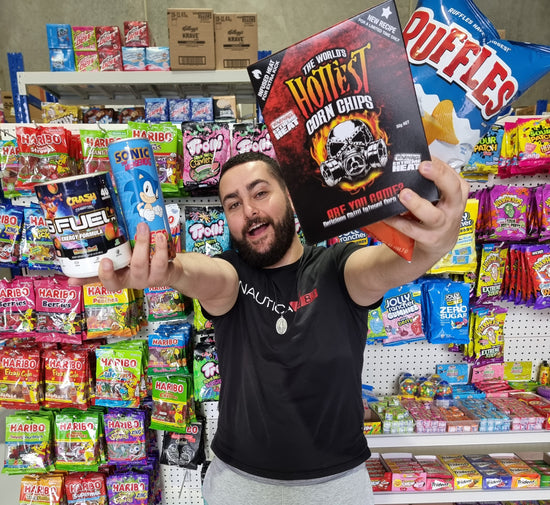I Luv Candi Fundamentals Explained
I Luv Candi Fundamentals Explained
Blog Article
All about I Luv Candi
Table of ContentsThe Greatest Guide To I Luv CandiGetting My I Luv Candi To WorkIndicators on I Luv Candi You Should KnowSome Known Factual Statements About I Luv Candi I Luv Candi Fundamentals Explained
You can also approximate your very own income by applying various presumptions with our economic prepare for a sweet-shop. Ordinary monthly income: $2,000 This sort of sweet-shop is often a little, family-run organization, maybe understood to residents but not bring in big numbers of vacationers or passersby. The store could offer a selection of usual sweets and a few homemade treats.
The shop doesn't usually bring uncommon or expensive things, concentrating instead on cost effective treats in order to keep normal sales. Assuming a typical spending of $5 per consumer and around 400 customers per month, the monthly income for this candy store would certainly be roughly. Typical monthly earnings: $20,000 This sweet shop advantages from its tactical area in an active urban area, drawing in a a great deal of clients seeking pleasant indulgences as they go shopping.

In enhancement to its diverse sweet option, this store may additionally offer related items like gift baskets, sweet bouquets, and uniqueness products, offering several income streams. The shop's place calls for a greater budget for rental fee and staffing however brings about higher sales volume. With an estimated typical spending of $10 per customer and concerning 2,000 customers monthly, this shop can produce.
I Luv Candi Fundamentals Explained
Located in a significant city and traveler destination, it's a huge facility, usually spread out over multiple floorings and potentially part of a national or global chain. The shop offers an enormous selection of sweets, consisting of special and limited-edition items, and goods like well-known garments and devices. It's not just a shop; it's a destination.
The operational expenses for this type of store are significant due to the location, dimension, personnel, and features supplied. Thinking a typical acquisition of $20 per customer and around 2,500 customers per month, this flagship store could achieve.
Classification Examples of Expenditures Average Monthly Expense (Range in $) Tips to Minimize Expenses Rent and Utilities Store rent, electrical energy, water, gas $1,500 - $3,500 Take into consideration a smaller sized area, bargain rental fee, and make use of energy-efficient illumination and home appliances. Inventory Candy, snacks, packaging materials $2,000 - $5,000 Optimize supply administration to lower waste and track preferred products to avoid overstocking.
Rumored Buzz on I Luv Candi
Advertising And Marketing check my reference Printed materials, on-line ads, promos $500 - $1,500 Emphasis on cost-efficient digital marketing and make use of social networks systems completely free promo. Insurance coverage Business liability insurance coverage $100 - $300 Search for competitive insurance coverage prices and think about bundling plans. Equipment and Maintenance Cash signs up, present shelves, repair work $200 - $600 Buy used devices when possible and do routine upkeep to extend tools life-span.

This indicates that the sweet store has reached a point where it covers all its dealt with expenditures and begins producing income, we call it the breakeven factor. Take into consideration an example of a sweet shop where the month-to-month set prices typically total up to about $10,000. A rough estimate for the breakeven factor of a sweet store, would certainly then be about (considering that it's the overall fixed price to cover), or offering in between with a price variety of $2 to $3.33 per unit.
The Best Strategy To Use For I Luv Candi
A huge, well-located sweet-shop would certainly have a greater breakeven factor than a tiny store that does not need much revenue to cover their costs. Curious concerning the success of your sweet store? Attempt out our straightforward monetary plan crafted for sweet-shop. Just input your own presumptions, and it will help you determine the quantity you require to make in order to run a lucrative company - spice heaven.
One more danger is competitors from other candy shops or bigger merchants who may offer a broader range of items at lower rates (https://www.goodreads.com/user/show/176854025-carol-lunceford). Seasonal fluctuations in demand, like a decrease in sales after holidays, can also affect success. In addition, transforming customer preferences for healthier treats or nutritional constraints can minimize the allure of traditional candies
Financial downturns that reduce customer spending can influence candy store sales and earnings, making it essential for sweet stores to handle their expenditures and adjust to changing market problems to remain successful. These hazards are commonly consisted of in the SWOT evaluation for a sweet-shop. Gross margins and net margins are vital indicators used to gauge the profitability of a sweet-shop service.
The Facts About I Luv Candi Uncovered
Basically, it's the revenue remaining after deducting prices straight pertaining to the sweet supply, such as acquisition prices from vendors, production expenses (if the candies are homemade), and staff wages for those included in production or sales. https://www.goodreads.com/user/show/176854025-carol-lunceford. Web margin, alternatively, factors in all the expenses the sweet-shop incurs, including indirect costs like management expenditures, advertising, lease, and taxes
Candy shops generally have a typical gross margin.For circumstances, if your sweet shop earns $15,000 per month, your gross revenue would be roughly 60% x $15,000 = $9,000. Think about a candy store that sold 1,000 candy bars, with each bar valued at $2, making the total earnings $2,000.
Report this page